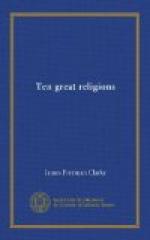or the Euphrates, these ardent and courageous propagators
of the Gospel probably proceeded to Khorassan,
and then crossing the Oxus, directed their course toward
the Lake of Lop, and entered the Chinese Empire
by the province of Chen-si. Olopen, and his
successors in the Christian mission, whether Syrians
or Persians by birth, certainly belonged to the
Nestorian church.
Voltaire, who did not like to trouble himself with scientific arguments, and who was much stronger in sarcasm than in erudition, roundly accuses the missionaries of having fabricated the inscription on the monument of Si-ngau-Fou, from motives of “pious fraud.” “As if,” says Remusat, “such a fabrication could have been practicable in the midst of a distrustful and suspicious nation, in a country in which magistrates and private people are equally ill-disposed towards foreigners, and especially missionaries, where all eyes are open to their most trivial proceedings, and where the authorities watch with the most jealous care over everything relating to the historical traditions and monuments of antiquity. It would be very difficult to explain how the missionaries could have been bold enough to have printed and published in China, and in Chinese, an inscription that had never existed, and how they could have imitated the Chinese style, counterfeited the manner of the writers of the dynasty of Thang, alluded to customs little known, to local circumstances, to dates calculated from the mysterious figures of Chinese astrology, and the whole without betraying themselves for a moment; and with such perfection as to impose on the most skilful men of letters, induced, of course, by the singularity of the discovery to dispute its authenticity. It could only have been done by one of the most erudite of Chinese scholars, joining with the missionaries to impose on his own countrymen.”
“Even that would not be all, for the borders of the inscription are covered with Syrian names in fine estranghelo characters. The forgers must, then, have been not only acquainted with these characters, but have been able to get engraved with perfect exactness ninety lines of them, and in the ancient writing, known at present to very few.”
“This argument of Remusat’s,” says another learned Orientalist, M. Felix Neve, “is of irresistible force, and we have formerly heard a similar one maintained with the greatest confidence by M. Quatremere, of the Academy of Inscriptions and Belles-Lettres, and we allow ourselves to quote the opinion of so highly qualified a judge upon this point. Before the last century it would have been absolutely impossible to forge in Europe a series of names and titles belonging to a Christian nation of Western Asia; it is only since the fruits of Assemam’s labors have been made public by his family at Rome, that there existed a sufficient knowledge of the Syriac for such a purpose; and it is only by the publication of




